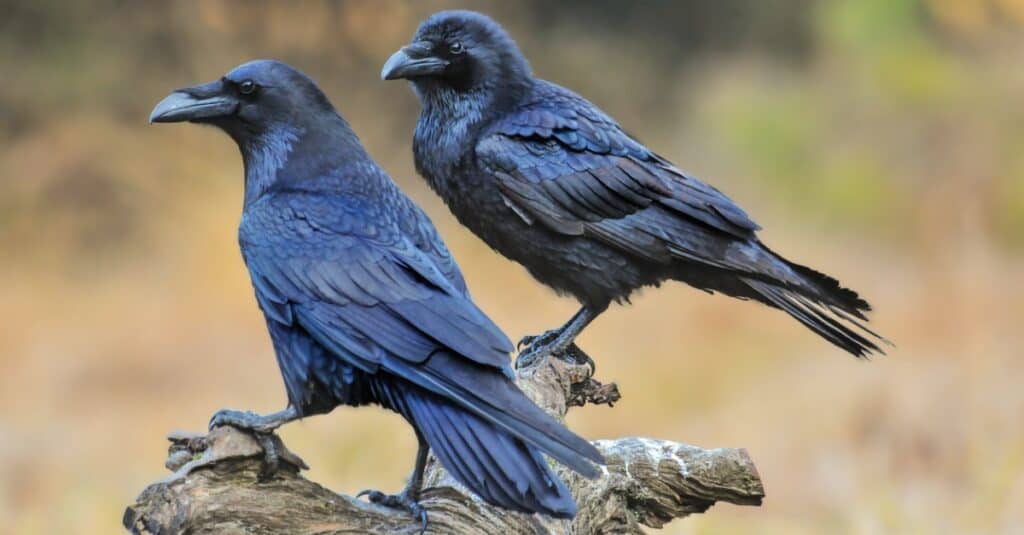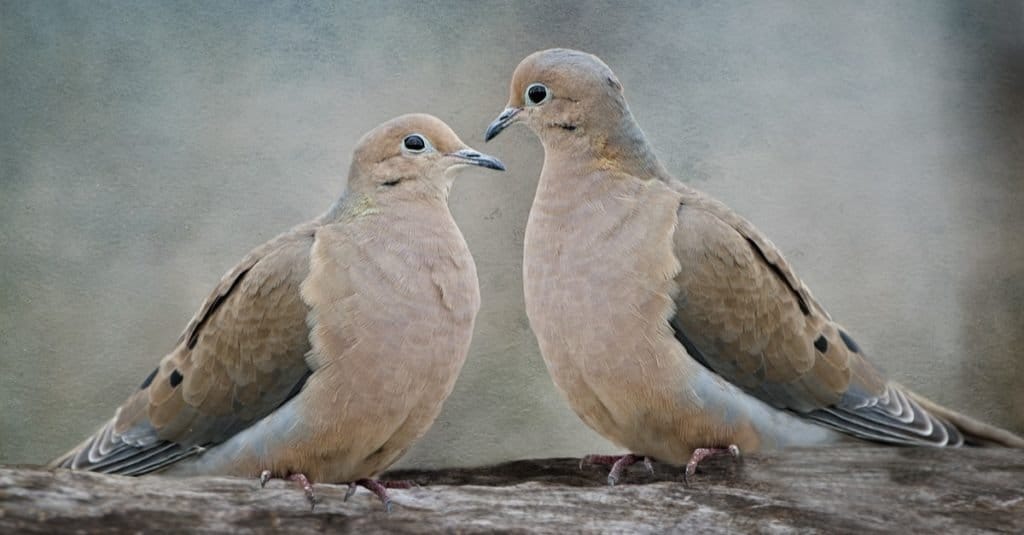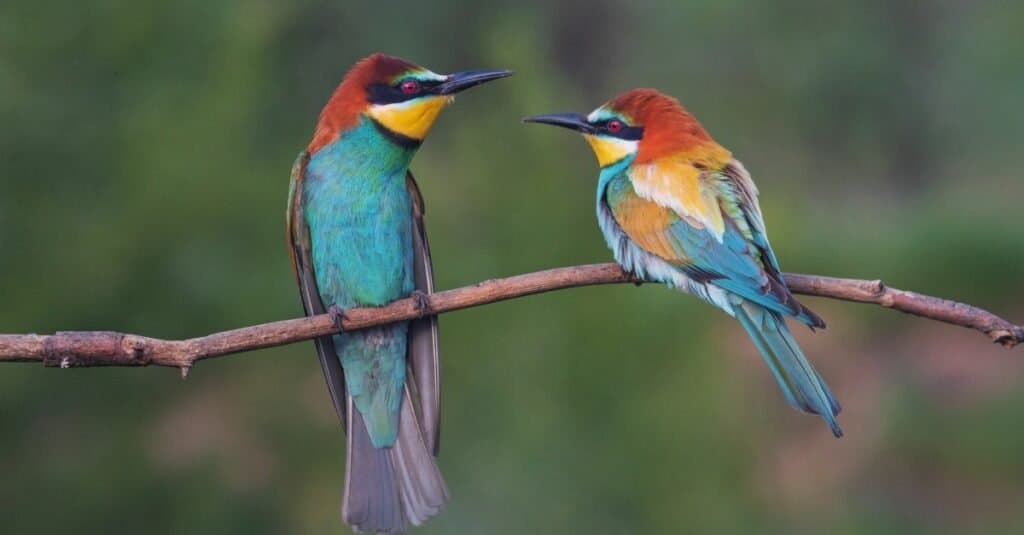Spring is in the air when the weather starts to warm. The feeling of spring is unlike anything else. There are plenty of outdoor adventures to go on, barbecues to have in the backyard, and picnics to go on. Spring is also the time when birds return to the skies. During this time, some birds may fill your ears with their beautiful song, while others will sound angry and loud. So what is the meaning behind all of this commotion? Well, have you ever wondered about birds’ mating season and when these animals breed?
It doesn’t matter where, when, or what species it is because breeding season arrives every year. Are you aware of when the breeding season is in your area? Is it possible to tell when birds are in love? Here’s everything we need to know about that and more!
When Is Bird Mating Season?

Ravens are considered early nesters as they begin breeding in February.
©Krasula/Shutterstock.com
As the weather warms, birds start mating in the spring. Nesting materials and food sources are in abundance during this time, which is why they breed in the spring. Most birds peak between March and July. However, the exact time varies from species to species. Bird species play an important role in their breeding behavior. Birds may breed later, migrate further, or produce multiple broods, depending on their breeding cycle.
The crossbill is an example of a wild bird whose nesting period is considered early. In January, they begin breeding, and the period lasts until the end of February. Other early nesters include ravens, long-tailed tits, and herons, which begin breeding in February. Among the late nesters, we have finches, swifts, sparrows, and martins. They all start to nest between April and May. A variety of factors influence when birds begin nesting and the length of their breeding season. Among them are climate, bird species, location, breeding system, and even physiological changes in birds.
It usually takes between a week and two for a breeding season to wind down. As the young mature, at least one parent will take care of them and help them become independent birds in due course. How do you know when bird mating season is about to begin? Come on, let’s find out!
What Are the Signs of Bird Mating Season?
So how do you know when bird mating season is about to begin? Well, there are actually several factors that will help you determine when the season has begun!
These factors include:
- Season change: Spring is the most common time for the breeding season to occur. This is a period when the snow is melting, and rain is occurring more frequently. The abundance of food and warmer temperatures make raising young easier for birds.
- Plants and flowers blooming: Are you noticing more plant life outside? The spring season is marked by the blooming of flowers and plants in gardens and yards. During the bloom cycle, migrating birds are driven north by evidence of new plant life.
- Change in bird’s appearance: Pay attention to the wild birds flying around, perched on trees, and visiting your bird feeder during the spring. Do they now have bright feathers and an improved appearance? Observe how the wild birds have become more territorial about their food and space. We are fast approaching the breeding season when these signs appear.
- The sounds of spring: You may hear something in the air if you listen carefully outside. You will notice an increase in bird songs as breeding season approaches! Singing helps wild birds attract mates and increase their attractiveness.
Bird Behavior During Mating Season

The courtship behavior of many birds is unique to them.
©Bonnie Taylor Barry/Shutterstock.com
As the breeding season approaches, what does bird behavior look like? It is important to note that a variety of expressions can be used to express courtship behavior. These include behaviors such as feeding one another, dancing, and grooming each other. The most extravagant courtship displays are often exhibited by sage-grouses or dancing birds of paradise. Furthermore, long-term partners have also developed special gestures and calls that help them reestablish their relationship after spending a long winter apart from one another.
For a deeper understanding, let’s examine the courtship behavior of certain bird species in more detail!
Courtship in Specific Bird Species
Birds are known to court each other in several different ways, as we mentioned above. In other words, each species of bird falls in love in its own unique way. Take a look at some of the more fascinating behaviors displayed by bird species as they court one another.
Sage-Grouse
The sagebrush grouse is a very large bird that is only found in the sagebrush lands of the western United States. In winter, it feeds primarily on the leaves of sage plants that grow on the ground. In spring, massive numbers of sage-grouse assemble on traditional dance grounds to perform courtship displays. As a means of attracting females, they strut with their chests puffed out and their short spiky tails spread.
Northern Cardinal
In order to display his interest in a female, the male northern cardinal uses two methods. He first displays his chest in a lopsided display where he twists his body to better display it. In the second courtship behavior, he sings and flutters toward the female while performing a song-flight display. The next phase in cardinal courtship involves the exchange of food between the male and female. A female cardinal often mimics a fledgling’s begging behavior with quivering wings to attract males.
Mourning Dove
There are several ways in which mourning doves communicate their feelings with each other. It begins with the birds preening mutually by nibbling on their head and neck feathers, a practice called allopreening. A male bird may then engage in ritual preening by stretching himself over his shoulder, digging into his feathers, and motioning his bill rapidly over his breast and neck. The male offers his open bill to a female, who inserts her beak into his, and both have a brief head-to-head interaction. You could almost call it the bird version of a human kiss.
Birds of Paradise

These beautiful birds of paradise are known for the males’ unique courtship dance.
©iStock.com/drakuliren
Birds of paradise are known for their spectacular display of courtship. In order to attract a female, a male may display his vivid feathers and call loudly while performing a mating dance on the ground, perched on a shrub, or hung upside down from a tree branch. There are two types of displays: those performed alone and those performed in a group with a competitive nature. It is the females who choose which males to mate with based on the displays.
However, after they have courted or have started on their families, birds can become quite territorial. Let’s find out all about their nesting behaviors.
Nesting Behavior Among Birds
When nesting season begins, a lot is on the line for birds. In order to retain their territory and protect their young, birds have developed some protection strategies. There will be some strange behaviors you observe at this time of year that you can only see around this time of year.
These behaviors may include the following:
- Aggressively collecting materials: When birds begin nesting, some will aggressively pull cotton threads or fur from your pet dog or cat in preparation for the nesting season. The reason for this behavior is that they are gathering nesting materials.
- Aggressive sounds and warning calls: Have you noticed a decrease in the beauty of bird songs and an increase in aggressive squawking noises? You’ll begin to notice that the sounds that birds usually make are being replaced with much more unusual ones. There are many warning calls about potential dangers, and hungry fledglings are making chirping sounds.
- Defensive behavior: There are many ways that birds defend themselves during the breeding season. Two of the most common ways include the broken-wing displays and dive-bombing. During the former, the bird pretends to have an injured wing as a distraction to distract people away from its nest. In the latter case, potential threats are frightened away by proactive action.
The photo featured at the top of this post is © Assoonas/Shutterstock.com
Thank you for reading! Have some feedback for us? Contact the AZ Animals editorial team.






